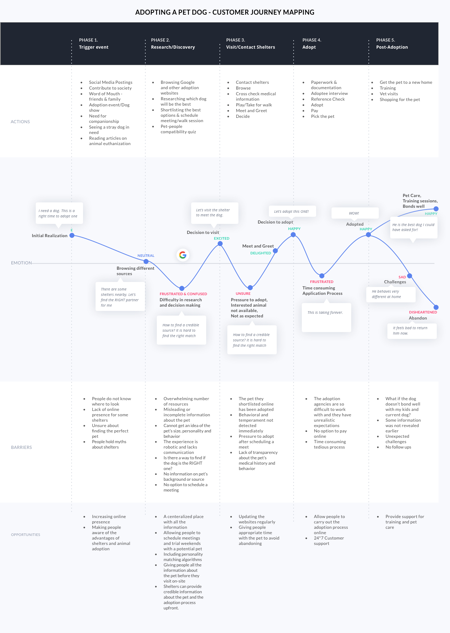Tubby
Platform that matches pets to people.


By partnering with shelters all over India, Tubby wants to create a platform that allows people to find their potential pet matches using a pet-to-people match algorithm. Awareness about the benefits of adoption and discoverability are the primary things Tubby wants to address.
Tubby - India (DesignLab)
July 2018- September 2018
Research, User Flows, Information Architecture, Sketching, Wireframing, UI, Prototyping
Pen & Paper, Sketch App, Invision
Tubby needed a website that allowed people to find their compatible pet in order to reduce the rate at which pet(s) are abandoned or returned to the shelters and at the same time increase the adoption satisfaction.
Tubby connects the potential pet adopters with the right animal companions. To accomplish this, the website features a Find Your Match compatibility quiz that narrow down the pets that best fit the potential adoptees.
A research plan was formulated to familiarize myself with the process flow for pet adoption, the services and programmes offered, channels for acquiring pets and roadblocks in adoption discoverability. I looked at the secondary sources such as humane society websites, social network, forums and blogs. .
PRIMARY RESEARCH

The qualitative data was instrumental in uncovering the users' motivations, purposes for adoption, process, and challenges. The quantitative data augmented understanding the adoptor's goals, process, and information organization.
User Interviews
I interviewed a diverse user group about their experiences with adopting pets. Three of them currently had rescue dogs or cats and had adopted in the past. One participant was looking to adopt a dog for the first time.

The biggest challenges faced
PERSONA
The collective needs and concerns of the interview participants led to the creation of user persona for Tubby.
JOURNEY MAP
The journey map captures a very likely scenario in a general sense based on my findings.The particular points of negative feelings include when people have difficulty finding the right pet with the desired criteria, exhausting application process, adopted pet not as expected, and no follow-ups from the shelters.

INFORMATION ARCHITECTURE
SITE MAP
Before I designed the low-fi wireframes, I made a sitemap of the product stages of possible interfaces that I might need to create. This method helped me to keep organized and see the overall experience from the interface point of view.

TASK FLOW
I mapped out the ssential task a user would complete on the site as well as the decisions he/she would have to make to adopt a pet. This type of map ensured that users could complete essential tasks in a logical and smooth way.

USER FLOW
Mapping out the user's journey from start to finish helped me ensure the pages flowed in a logical and smooth way.

LOW FIDELITY WIREFRAMES
Next I moved on to create low-fidelity wireframes. The wireframes were developed with the intention to quickly translate into a prototype.
KEY SCREENS
BRANDING - STYLE GUIDE
I started designing Tubby’s visual direction by determining three key words for the brand: Warm, Playful, and Friendly . These adjectives came directly from the user interviews and connects to the users' need for emotional connection and trust in the adoption process.
Next, I refined the direction of the visual design to create a logo and a styleguide for Tubby.

HIGH FIDELITY PROTOTYPE
With the final branding decisions in hand I developed a revised set of high-fidelity mockups. These new wirerames show how the visual design will be applied and reflect changes I made based on user feedback obtained from the low-fidelity wireframes.
INTERACTIVE PROTOTYPE
Once I completed all my Hi-Fi mockups, I created an interactive prototype using Invision. I then used this prototype to validate my design solutions. The prototype functionality is limited to three major tasks.
I conducted usability testing of the hi-fidelity prototype with 8 users. Using the results from usability testing, I created an affinity map synthesizing successes and challenges. I then identified next steps for high-fidelity screens.
AFFINITY MAP
I created an affinity map to synthesize the findings from my usability testing. I grouped user actions and comments into alike categories. Finally, I sorted them into successes, errors, patterns and improvements.
This helped me address issues on the current working prototype and provide design recommendations.

Based on my testing results, I iterated my high-fidelity wireframes and re-created the prototype.
Working through a project end-to-end is truly exciting and exhausting at the same time. There were times when I felt I may have spent too much time on research. Overall it was quite an interesting experience.
It is always nice to create something that has a social impact. I solved the problem of mismatched animals and adopters by designing a website that pairs pets with adopters who are more likely to maintain and care for their companions. I used discovery research methods to find users' real problems when adopting a pet. Throughout the project, I used evaluative research to test and validate my design decisions. This resulted in a functional, usable prototype that was aligned with user needs.
Tubby is not meant to substitute actual shelter visits and physical meet-and-greets with the pet. The site’s main intent is to find a pet that is compatible to the lifestyle and personality of the adopter. It facilitates the beginning stages of the pet search process for users by matching them with potential companions.